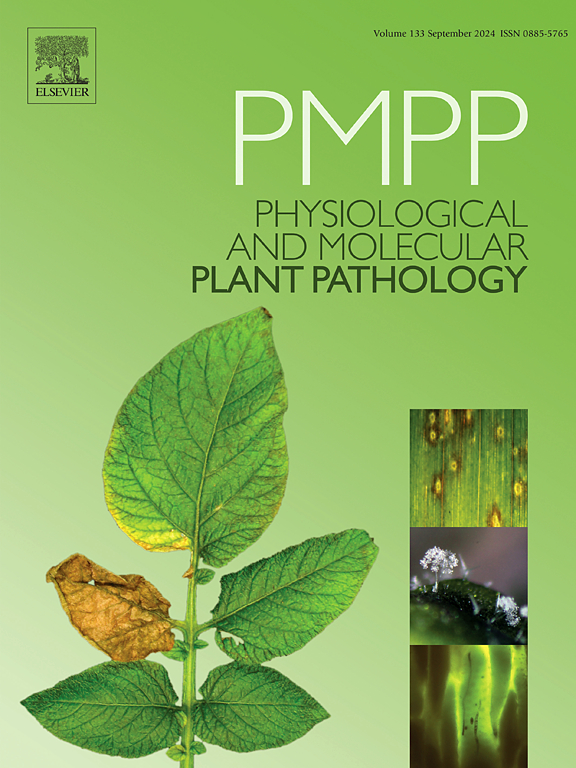Fungal diversity associated with cherry leaf spot in Yantai city, Shandong province, China
IF 2.8
3区 农林科学
Q2 PLANT SCIENCES
引用次数: 0
Abstract
Cherry leaf spot disease causes yield and economic loss in many cherry-growing areas. In 2023, a field survey on cherry leaf spot was carried out in Yantai city, Shandong province, and 106 fungal isolates were obtained from randomly sampled diseased leaves. Based on morphological observations and molecular phylogenetic analysis, the fungal isolates were classified into 11 species, including Colletotrichum aenigma (32.08 %), Colletotrichum siamense (11.32 %), Colletotrichum gloeosporioides (10.38 %), Alternaria alternata/tenuissima species complex (31.14 %), Fusarium lateritium (4.72 %), Fusarium verticillioides (2.84 %), Nothophoma quercina (1.88 %), Clonostachys rosea (1.88 %), Epicoccum nigrum (1.88 %), Nigrospora oryzae (0.94 %), and Diaporthe sojae (0.94 %). Among these, Colletotrichum spp. was the most dominant genus. All isolates exhibited the ability to infect cherry leaves, with E. nigrum displaying the highest virulence and Cl. rosea the lowest. Symptoms on potted seedlings following artificial inoculation closely resembled those observed in field-grown plants under natural infection. All other isolates, except Cl. rosea, showed pathogenicity on cherry fruits. Notably, Ni. oryzae and Cl. rosea represent the first reports of leaf spot disease in sweet cherry. This study systematically investigated cherry leaf spot disease, providing valuable insights into the pathogenic factors responsible for the disease. Furthermore, this study also provides a solid theoretical basis for the formulation of field control strategies for cherry leaf spot disease.
山东省烟台市樱桃叶斑病真菌多样性研究
樱桃叶斑病在许多樱桃种植区造成产量和经济损失。2023年,在山东省烟台市对樱桃叶斑病进行了实地调查,从随机抽样的病叶中分离出106株真菌。通过形态学观察和分子系统发育分析,将分离到的真菌分类为11种,分别为:炭疽菌(32.08%)、炭疽菌(11.32%)、炭疽菌(10.38%)、炭疽菌/藤孢菌复合体(31.14%)、红土镰刀菌(4.72%)、黄萎病镰刀菌(2.84%)、槲皮菌(1.88%)、玫瑰镰刀菌(1.88%)、黑表皮菌(1.88%)、米黑孢子菌(0.94%)、黄萎病菌(1.88%)、黄萎病菌(1.88%)和黑孢菌(0.94%)。Diaporthe sojae(0.94%)。其中以炭疽菌属(Colletotrichum spp.)为优势属。所有菌株均表现出感染樱桃叶片的能力,其中黑孢杆菌表现出最高的毒力和Cl。玫瑰最低。盆栽苗人工接种后的症状与自然侵染的田间植株相似。所有其他的分离株,除了Cl。玫瑰病菌对樱桃果实有致病性。值得注意的是,倪。米和氯。玫瑰是甜樱桃叶斑病的首次报道。本研究对樱桃叶斑病进行了系统的研究,为了解该病的致病因素提供了有价值的见解。此外,本研究也为樱桃叶斑病田间防治策略的制定提供了坚实的理论依据。
本文章由计算机程序翻译,如有差异,请以英文原文为准。
求助全文
约1分钟内获得全文
求助全文
来源期刊
CiteScore
4.30
自引率
7.40%
发文量
130
审稿时长
38 days
期刊介绍:
Physiological and Molecular Plant Pathology provides an International forum for original research papers, reviews, and commentaries on all aspects of the molecular biology, biochemistry, physiology, histology and cytology, genetics and evolution of plant-microbe interactions.
Papers on all kinds of infective pathogen, including viruses, prokaryotes, fungi, and nematodes, as well as mutualistic organisms such as Rhizobium and mycorrhyzal fungi, are acceptable as long as they have a bearing on the interaction between pathogen and plant.

 求助内容:
求助内容: 应助结果提醒方式:
应助结果提醒方式:


